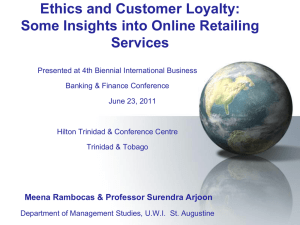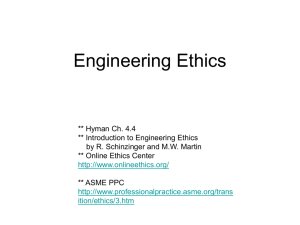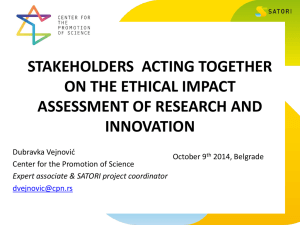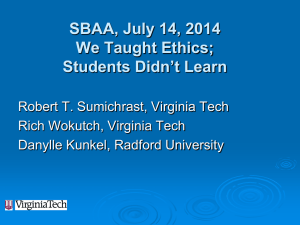Chapter 1
advertisement
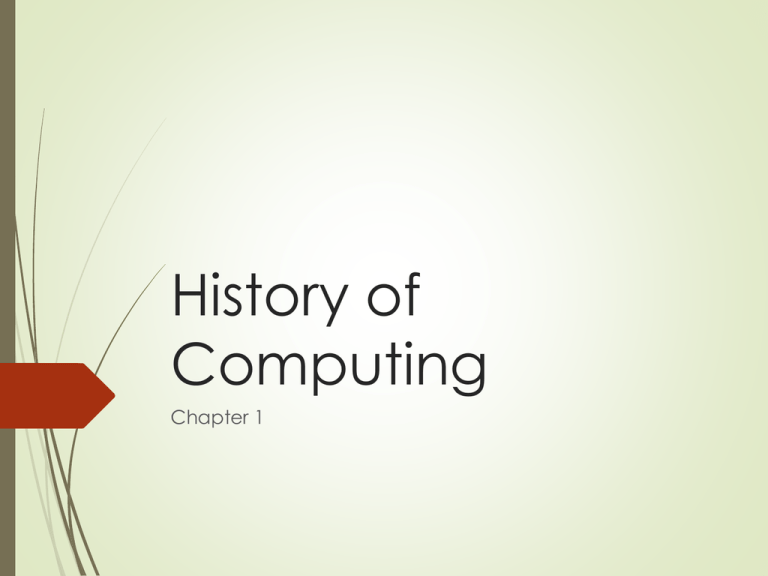
History of Computing Chapter 1 Introduction to Social and Ethical Computing Historical Development of Computing Development of the Internet Development of the World Wide Web The Emergence of Social and Ethical Problems in Computing The Case for Computer Ethics Education Historical Development Before 1900AD Man sought to improved life through the invention of gargets. First utility tools recorded dealt with numbers First recorded on bones – 20,000 to 30,000 B.C. First place-value number system in place – 1800 B.C. Abacus – Mother of Computers – 1000 B.C. and 500 B.C. Zero and Negative Numbers – 300 B.C. and 500 A.D. 1500AD and 1900AD lot of activities in the development of computing devices Driven by commerce 1500 Leonardo da Vinci invented mechanical calculator 1621 invention of the slide rule 1625 Wilhelm Schichard’s mechanical calculator in 1640 Blaise Pascal’s Arithmetic Machine Major breakthrough in speed up 1800 AD with the invention of the punched card by Joseph-Marie Jacquard Revolutionized computing Quickly spread in other fields Speed up computation and storage of information Historical Development Before 1900AD 1830 AD exciting period 1830 - Charles Babbage’s Analytical Engine George and Edward Schutz’s Difference Engine Within a decade - major milestone George Boole’s invention of Boolean Algebra Opened fields of mathematics, engineering, & computing Lead to the new frontiers in logic Historical Development Before 1900AD Mid 1850 through the turn of the century 1857 - Sir Charles Wheatstone’s invention Paper tape to store information Created new excitement in the computing community of the time. Huge amounts of data could be entered & stored 1869AD - Logic Machine by William Stanley Jovons ~1874 - first Keyboard by Sholes 1881 - Rectangular Logic Diagrams by Allan Marquand Historical Development Before 1900AD Mid 1850 through the turn of the century 1886, Charles Pierce - first linked Boolean Algebra to circuits based on switches Major break through in mathematics, engineering and computing science 1890 - John Venn invented the Venn diagrams Used extensively in switching algebras in both hardware and software development 1890 - Herman Hollerith invented the Tabulating Machine Utilized Jacquard’s punched card to read the presence or absence of holes. The data read was to be collated using an automatic electrical tabulating machine Large number of clock-like counters Summed up and accumulated the results in a number of selected categories. After 1900 AD Computing in infancy Century began with a major milestone Vacuum tube by John Ambrose Fleming. Played a major role in computing for the next half century. All digital computer in the first half century ran on vacuum tubes. 1906 - triode by Lee de Forest in 1906. 1926 - first semiconductor transistor Not used for several years Came to dominate the computing industry in late years 1937 - Turing Machine by Alan Turing Invention of an abstract computer Some problems do not lend themselves to algorithmic representations, not computable 1942 - COLOSSUS, one of the first working programmable digital computers After 1900 AD 1942 – Turing designed COLOSSUS One of the first working programmable digital computers 1939 – Vincent Atanasoff – 1st digital computer model utilized capacitors to store electronic charge to represent Boolean numbers 0 and 1 used by the machine in calculations Input and output data was on punched cards Some doubt it ever worked After 1900 AD Howard Aiken – developed Harvard Mark I 1st large scale automatic digital computer. also known as IBM automatic sequencer calculatorASCC 1943, Alan Turing – COLOSSUS Considered 1st programmable compute designed to break the German ENIGMA code used about 1800 vacuum tubes execute a variety of routines. After 1900 John William Mauchly & J. Presper Eckert Jr - ENICAC Vacuum tube-based general purpose 10 feet high Weighed 30 tons Occupied 1000 square feet 70,000 resistors 10,000 capacitors 6000 switches 18,000 vacuum tube No internal memory Hard-wired Consistently programmed by switches and diodes After 1900 1944-1952 John William Mauchly & J. Presper Eckert Jr – EDVAC Electronic discrete variable automatic computer 1st truly general purpose digital computer Stored program instruction concept completed in 1956 4,000 vacuum tubes and 10,000 crystal diodes 1948 - UNIVAC I 1st commercially available computer. After 1900 Many companies became involved International Business Machines (IBM), Honeywell, and Control Data Corporation (CDC) in the USA, and International Computers Limited, (ICL) in UK Built mainframe Hugh – took entire rooms Expensive – use limited to big corporations Mid to late sixties Developed less expensive but smaller computer Minicomputer Timesharing concept Let to idea of networking After 1900 1971 and 1976 - first microprocessor Built with integrated circuit with many transistors on a single board Vacuum tubes and diodes no longer used Ted Hoff The 4004 4-bit data path 1972 – Intel - 8008 8-bit microprocessor based on the 4004 fIrst microprocessor to use a compiler Specific application microprocessors Microprocessor 1974 -truly general purpose microprocessor 8080 -8-bit device - 4,500 transistors & astonishing 200,000 operations per second After 1974, development exploded Computer Software and Personal Computer (PC) Until mid 1970s Development led by hardware Computers were designed and software was designed to fit the hardware. Personal computing industry began 1976 - Apple I and Apple II microcomputer were unveiled 1981 - IBM joined the PC wars 3 Major Players IBM Gary Kildall - Developed the first PC operating system Bill Gates - Developed the Disk Operating System (DOS). The Development of the Internet Internet based on 4 technologies Telegraph Telephone Radio Computers Originated from the early work of J.C.R. Licklider Conceptualized a global interconnected set of computers Concept for communication between network nodes Packets instead of circuits Enabled computers to talk to each other. 1961 - Kleinrock Published first work on packet switching theory The Development of the Internet Two additional important projects Donald Davies and Roger Scantleberg Coining the term packet Connected computer in Boston with one in Los Angels Low speed dial-up telephone line created the first working Wide Area Network 1967 Roberts - publishing the first plan for ARPNET 1968 - team, lead by Frank Heart and included Bob Kahn, developed IMP ARPNET Began as tool for defense contractors Universities added Government joined Other countries joined ARPANET ceased to exist in 1989 Internet was an entity to itself Development World Wide Web Beginning concepts - Tim BernersLee’s 1989 Proposal called HyperText and CERN Enable collaboration between physicists & researchers in the high energy physics research Three new technologies were incorporated. HyperText Markup Language (HTML) hypertext concepts- to be used to write web documents HyperText Transfer Protocol (HTTP) a protocol Used to transmit web pages between hosts Web browser client software program to receive and interpret data and display results. Development World Wide Web Proposal included a very important concept for the user interface Consistent across all types of computer platforms Enable users to access information from any computer. Line-mode interface was developed & named at CERN in late 1989 Development World Wide Web Growth Central computer at CERN with few web pages in 1991 50 world wide by 1992 720,000 by 1999 Over 24 million by 2001 1993 - graphic user interface browser Mosaic Popularized and fueled growth of internet Emergence of the Social & Ethical Problems in Computing The Emergence of Computer Crimes Perhaps started with the invention of the computer virus The term virus is derived from a Latin word virus which means poison Computer virus Self-propagating computer program Designed to alter or destroy a computer system resource Spreads in the new environment Attacks major system Weakens the capacity of resources to perform 1972 – virus used to describe piece of unwanted computer code Growth of Computer Vulnerabilities The Case for Computer Ethics Education What is Computer Ethics James H. Moore First coined the phrase "computer ethics“ Computer ethics is the analysis of the nature and social impact of computer technology and the corresponding formulation and justification of policies for the ethical use of such technology . Definition focuses on the human actions Study, an analysis of the values of human actions influenced by computer technology. Computer influence on human actions is widespread throughout the decision making process preceding the action Education we study the factors that influence the decision making process Why You Should Study Computer Ethics Central task of computer ethics determine what should be done Especially whenever there is a policy vacuum Vacuums caused by the ‘confusion’ between the known policies and what is presented Professionals unprepared to deal effectively with the ethical issues Can stop the vacuums Can prepare the professionals Schools of Thought Study computer ethics as remedial moral education Computer ethics education not as a moral education but as a field worthy of study in its own right Justification for First Thought We should study computer ethics because doing so will make us behave like responsible professionals. We should study computer ethics because doing so will teach us how to avoid computer abuse and catastrophes. Material taken from Walter Manner in “Is Computer Ethics Unique?” Justification for Second Thought We should study computer ethics because the advance of computing technology will continue to create temporary policy vacuums. We should study computer ethics because the use of computing permanently transforms certain ethical issues to the degree that their alterations require independent study. We should study computer ethics because the use of computing technology creates, and will continue to create, novel ethical issues that require special study. We should study computer ethics because the set of novel and transformed issues is large enough and coherent enough to define a new field Material taken from Walter Manner in “Is Computer Ethics Unique?”





